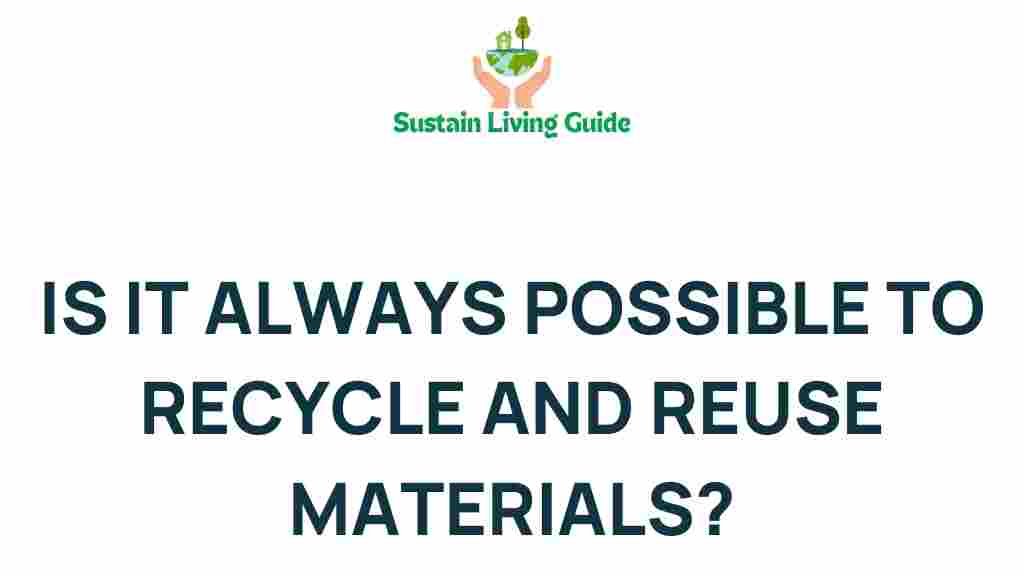The Limits of Recycling: Can We Truly Reuse Everything?
Recycling has long been heralded as a solution to our growing waste problem. As environmental awareness increases, many people are becoming more conscious of their consumption habits and the impact of their waste on the planet. However, while recycling plays a crucial role in waste management, it is essential to understand the limits of recycling and the reality of what can and cannot be reused. In this article, we will explore the concept of recycling, its benefits, limitations, and the challenges that come with attempting to reuse everything.
Understanding Recycling
Recycling is the process of converting waste materials into new products, thereby reducing the consumption of fresh raw materials, energy usage, and pollution. The recycling process involves several steps:
- Collection: Waste materials are collected from various sources, including households, businesses, and public spaces.
- Sorting: Collected materials are sorted by type, such as plastics, metals, paper, and glass.
- Processing: Sorted materials are cleaned and processed into raw materials that manufacturers can use to create new products.
- Manufacturing: New products are manufactured from recycled materials.
- Purchasing: Consumers buy products made from recycled materials, completing the recycling loop.
Despite these well-defined steps, not all materials can be recycled, and many face significant challenges in the recycling process. Understanding these limits is crucial for effective waste management.
What Can Be Recycled?
Before delving into the limits of recycling, it’s important to note which materials can typically be recycled:
- Plastics: Many types of plastics, particularly #1 (PETE) and #2 (HDPE), are widely accepted for recycling.
- Metals: Aluminum and steel cans are highly recyclable and can be processed indefinitely without loss of quality.
- Paper: Most paper products, such as newspapers, cardboard, and office paper, can be recycled.
- Glass: Glass bottles and jars are infinitely recyclable, provided they are clean and sorted properly.
However, even these materials have limitations. For example, contaminated plastics or mixed materials can complicate the recycling process, leading to lower recycling rates.
The Limits of Recycling
While recycling holds great promise, it is not a panacea for our waste crisis. Here are some of the significant limits to recycling:
1. Contamination Issues
One of the most significant barriers to effective recycling is contamination. When recyclable materials are mixed with non-recyclable waste, it can lead to entire batches being sent to landfills. Common contaminants include:
- Food residues on containers
- Non-recyclable plastics mixed in with recyclable ones
- Improperly sorted materials that confuse recycling systems
2. Economic Viability
The economic aspect of recycling is another limiting factor. The cost of processing recyclable materials can sometimes exceed the value of the recycled products. Factors that influence economic viability include:
- Market demand for recycled materials
- Cost of labor and transportation
- Quality of the recycled materials
For example, when oil prices are low, virgin plastic becomes cheaper than recycled plastic, making it less attractive for manufacturers to use recycled materials.
3. Technological Limitations
Recycling technologies are advancing, but there are still many materials that cannot be efficiently recycled. Some examples include:
- Composite materials: Products made from a mixture of materials, such as certain types of packaging and electronics, are challenging to recycle.
- Multi-layer packaging: Items like juice boxes and snack wrappers often contain layers that are difficult to separate for recycling.
- Certain plastics: Plastics #3 (PVC), #6 (PS), and #7 (other) often have limited recycling options.
4. Consumer Behavior
Ultimately, recycling also depends on consumer behavior. Many people are unaware of what can or cannot be recycled, leading to improper disposal. Enhancing public awareness through education is crucial, yet it remains a challenge.
Step-by-Step Process for Effective Recycling
To maximize recycling efforts, individuals and communities can adopt a systematic approach:
1. Educate Yourself
Understanding local recycling guidelines is vital. Check local government resources or environmental organizations to learn about what can be recycled in your area.
2. Proper Sorting
Make sure to clean and sort your recyclables correctly. Rinse containers to remove food residues, and separate materials based on your local guidelines.
3. Reduce Contamination
To avoid contamination, do not include non-recyclable items in your recycling bin. Common mistakes include:
- Plastic bags
- Pizza boxes
- Styrofoam containers
4. Stay Informed
Regularly update your knowledge about recycling practices and changes in policies. Follow local news and environmental organizations for updates.
Troubleshooting Common Recycling Issues
Even with the best intentions, recycling efforts can run into problems. Here are some common issues and how to address them:
1. Confusion About What’s Recyclable
If you’re unsure whether an item is recyclable, check with local guidelines or use apps that help identify recyclables.
2. Excessive Waste from Packaging
Consider reducing waste by purchasing products with minimal packaging or opting for bulk items. This not only reduces waste but also lowers costs.
3. Recycling Bin Overload
If your recycling bin fills up quickly, consider reducing your overall consumption or participating in community recycling programs. Some areas have drop-off locations for excess recyclables.
Conclusion
Recycling is a critical component of waste management, but it has its limits. Understanding what can be recycled, the challenges involved, and the importance of consumer behavior can help us navigate the complexities of waste disposal more effectively. While we cannot truly reuse everything, we can take significant steps toward minimizing waste through informed recycling practices.
For more information on how to improve your recycling efforts, check out this comprehensive guide from the Environmental Protection Agency. Remember, every small action counts when it comes to protecting our planet.
By acknowledging the limits of recycling and promoting responsible consumption, we can work towards a more sustainable future. Together, we can make a difference!
This article is in the category Waste and created by SustainLivingGuide Team
